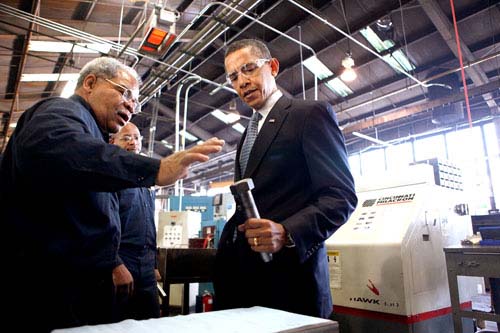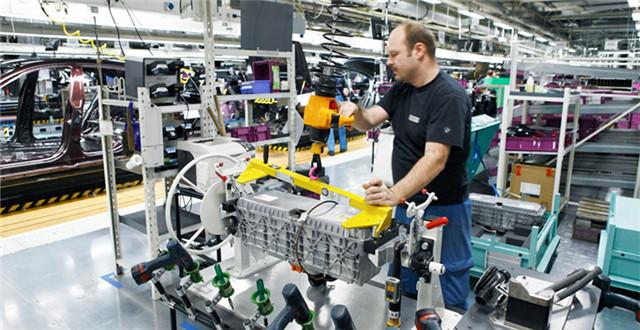Shifting tides of public opinion sway US industrial policy

US President Barack Obama was visiting a factory in the State of Ohio in 2009, since when reindustrialization has been made a basic national policy by his government.

Currently, American manufacturing industry is reviving with the support from the reindustrialization policy.
A central feature of the Obama administration’s economic program to revive American industry, reindustrialization signals that a shift in US economic policy has taken place since the financial crisis.
Though it was first proposed in the late 1970s and early 1980s, this policy has never been implemented until now, prompting experts in the field to ponder why. One must carefully review the debates over reindustrialization that have occurred since the 1980s to reveal how public opinion sways the policy-making of the US government.
AFL-CIO advocacy
Disputes on reindustrialization in the US have been closely related to deindustrialization in the country’s economic sector. In the 1970s and 1980s, America faced potent economic challenges from Japan and Germany.
At the same time, its domestic economy slid into crisis. Excessive inflation and unemployment coexisted. According to public opinion, the source of the economic woes was the process of deindustrialization. Citizens called on the US government to take steps to reverse this economic trend.
The editors of American magazine Bloomberg Businessweek (known until 2010 as Business Week) took the lead in stirring up the economic debate. In June 1980, the magazine published a special issue titled “The Reindustrialization of America” focusing on the “downturn” of American industry. It explicitly pointed out that the United States needed radical reforms to reinvigorate its economy and maintain its role as a global leader.
Two months later, the American Federation of Labor and Congress of Industrial Organization (AFL-CIO), the largest US labor union, released a statement about reindustrialization, proclaiming that the healthy development of American economy requires a strong industrial basis to ensure the production of goods that truly meet the needs of US citizens.
However, conservatives asserted that the government itself is the biggest obstacle to the development of American industry, arguing that market forces need to play out unabated. They maintained that the root cause of economic depression was government intervention—the policies of Keynesianism and the welfare state created by the New Deal had distorted the market, imposing a burden on enterprises thereby diminishing their capacity for innovation.
The rise of the Reagan administration ended the debate, with the conservative supply-side school taking the upper hand. The victory of the conservatives was closely related to public opinion. Reagan insisted on solving US industrial problems by adopting supply-side economics, which meant an abandonment of protective industrial policy.
Outsourcing opposed by public
Within the context of accelerating globalization, enterprises began increasingly relocating operations outside American borders at the turn of the 21st century. Offshore business and the outsourcing of manufacturing and services have rapidly developed, further advancing the process of deindustrialization.
The economic recession from 2001 to 2002 once again stirred debate within American society on reindustrialization, which arose as the most heatedly discussed economic issue in the presidential elections of 2004.
Forrester Research released a report in 2002 estimating that a total of 3.3 million job opportunities flowed to overseas countries due to outsourcing. This caused a social uproar in the United States that directed at the outsourcing of multinational corporations, which were seen as denying job opportunities to the American people.
Criticisms of outsourcing peaked in 2004. In February of that year, the Bush Administration released the Economic Report of the President. The report stated that if a product or a service can be produced or offered more cheaply, importation is preferred over domestic production or service. Nicholas Gregory Mankiw from Harvard University, who served as the President of the Council of Economic Advisers (CEA) at the time, concurred at the public hearing hosted for the report in the Congress.
At the same time, Democratic members of Congress took action against outsourcing. For example, Edward Kennedy, the US Senate of the Massachusetts proposed the Job Opportunity Left to Americans in February 2004. Christopher Dodd, a Democratic Senator from Connecticut, suggested the passage of the Workers’ Protection Act, which called for limitations on US companies eligible to outsource business.
Though these acts were not passed in the end, they were effective in terms of alerting people to the importance of making outsourcing a legislative issue. The Bush administration also at the very least made a nominal concession on the issue. George W. Bush signed into law an act forbidding the outsourcing of government to overseas companies.
Pressured by public opinion, Bush authorized the Department of Commerce to release a report detailing a comprehensive strategy to boost the manufacturing industry by elevating its position in the global market through refining the competitive environment. However, to the opponents of outsourcing, their hopes for direct government intervention through protective policy were never realized.
Reindustrialization as basic policy
Former head of the Federal Reserve Alan Greenspan said the financial crisis that broke out in 2008 was the greatest hit on the United States since the Great Depression, and it exposed many profound flaws of the American economy. The crisis not only catalyzed the shift of political power within the United States but also prompted another round of debate on reindustrialization in many government, industrial and academic circles with unprecedented breadth and depth.
The manufacturing enterprises and labor unions vigorously advocated the policy of reindustrialization. On July 2009, the Alliance for American Manufacturing (AAM) issued the report “Manufacturing a Better Future for America.” The government was called upon to protect the US manufacturing industry by making trade policies, providing skill training and investing more in R&D.
In April 2010, a study conducted by the Committee for Industrial Organization of the AFL-CIO and the American Steel Corporation pointed out that American manufacturing industry faced a severe crisis, proposing national strategies in the fields of trade, exchange rate, tax, investment, techniques and labor force to support the development of the manufacturing industry.
In the academic field, the American Vision published a special issue in the beginning of 2010 that comprehensively analyzed the plight of the American manufacturing industry as well as its implications for the country’s future.
The US government was once again petitioned to make industrial policies to foster the development of the manufacturing industry. From 2008 to 2012, some of America’s think tanks, particularly the Economic Policy Institute, the Brookings Institution, the Center for American Progress, the New American Foundation and other pro-Democratic think tanks also released reports to illustrate the uniqueness of manufacturing and its essentiality to the United States.
In the grim context of financial crisis, public opinion regarding domestic policy clearly favored liberals. After reindustrialization was made a pillar of basic national policy in 2009 by the Obama government, a series of actions aimed at fostering reindustrialization was taken. When Obama was elected to his second term in 2012, he further stressed the importance of the manufacturing industry.
As he explicitly remarked: “We won’t go back to a weakened economy burdened by outsourcing, odious debts and fake financial profit.” A long-term economic blueprint should be built in order to reignite the engine of American economic growth—a rising, prosperous middle class, he said.
The three undercurrents of social debate on American’s reindustrialization were all closely related with the country’s public opinion, which is regarded as the expression of social inclination. Therefore, it can be inferred that the decision-making of US government on one hand, is relatively consistent with the country’s public opinion, while on the other hand, it is susceptible to instable factors because public opinion, to some extent, tends to be manipulated by power.
Huang Jian’an is from the Institute for Public Policy Research of Zhejiang Academy of Social Sciences.
